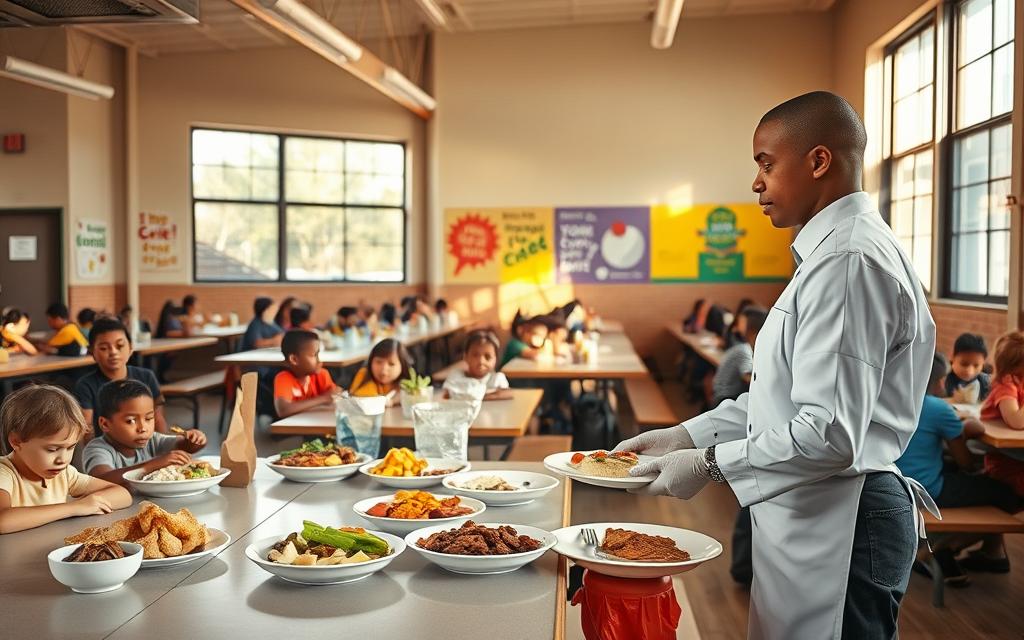Advertisement
Did you know over 13 million children in the United States get free school meals every day? For many families, finding healthy food can be hard, outside of public schools. Groups offering meal support help a lot.
There are many places offering free school lunches to students who need them. These efforts are key. They make sure kids from all schools get healthy food. This helps their health and school work.
Knowing where to find free school meals outside public schools can change lives. It’s a big help for families facing these issues. Let’s look at how to get this important help.
Understanding Nonprofit School Meals
For many students, nonprofit school meal programs are a lifeline. They ensure students get the nutrition they need to succeed. These programs support students’ health and well-being, helping in communities where nutritious food is hard to find.
What Are Nonprofit School Meals?
Nonprofit school meals come from groups outside the usual school system. These groups help students get at least one nutritious meal a day. They work with local food banks and community groups to do this.
Nutritional Value: These meal programs focus on balanced meals that follow dietary guidelines. Meals include fresh fruits, vegetables, whole grains, and lean proteins. This helps students stay focused and full of energy all day.
Benefits of Nonprofit Meal Programs
Nonprofit meal programs do more than just feed students. They support students’ overall growth. By keeping students well-nourished, these programs help improve grades, reduce absences, and boost health.
- Increased Academic Performance: Well-fed students do better in school. They have the energy and focus to learn well.
- Reduced Absenteeism: Reliable meals help students miss fewer days of school. This is because hunger or food insecurity is less of a problem.
- Better Health Outcomes: Healthy meals prevent malnutrition-related health issues. This supports students’ overall health.
Also, these programs are community hubs. They bring students, families, and local groups together. This community support is as valuable as the meals themselves, offering help and resources.

Understanding nonprofit school meals shows their crucial role in education and personal growth. As we look at school meal options, it’s clear that nonprofits are key. They make sure all students get the nutrition they need to succeed.
Types of Nonprofit Organizations Providing Meals
Many nonprofit groups help with hunger relief by offering meals. They are key in helping students who don’t have enough food. This ensures they get the nutritious meals they need.
Food Banks and Pantries
Food banks and pantries lead in fighting hunger. They gather, store, and give out food to those who need it. They often work with schools to feed families.
Food banks are crucial in helping school meal programs. This is true during summer or holidays when school is closed.
Some food banks also teach about nutrition and cooking. For example, Feeding America helps with food and resources to fight hunger across the country.
| Organization Type | Services Provided | Target Beneficiaries |
|---|---|---|
| Food Banks | Food Distribution, Nutrition Education | Families, Students |
| Pantries | Food Distribution | Individuals, Families |
Community Action Agencies
Community Action Agencies (CAAs) are also vital. They work to reduce poverty and improve life for low-income people. They offer meal programs for students.
CAAs team up with local communities to find and solve problems. They run food help, after-school meals, and summer feeding programs. These are all to support students’ food needs.
Faith-Based Organizations
Faith-based groups also help by offering meals. Churches, synagogues, mosques, and other places of worship run food programs. They focus on helping the most at-risk, like kids.
These groups often work with other nonprofits, government, and community groups. Their help is key in areas where food is hard to find.
In summary, the variety of groups fighting hunger shows the depth of efforts to help students. From food banks to faith-based groups, each plays a unique role in feeding those in need.
Local Resources for Free School Meals
There are many ways to get free school meals in your area. You can find them through schools, community events, and non-profits. These groups help a lot with students from low-income families.
Schools with Free Meal Programs
Many schools offer free meals to students. These programs get money from the government or non-profits. Parents can call their school district or check the school’s website to find these programs.
Benefits of School Meal Programs include good nutrition and better focus and learning. Schools with these programs see better grades and more students coming to class.
| School District | Program Name | Eligibility Criteria |
|---|---|---|
| District 1 | Free Meal Initiative | Income below 185% of poverty level |
| District 2 | Nutrition Support | Families receiving SNAP benefits |
| District 3 | Student Meal Assistance | Students in foster care |
Community Events Offering Free Meals
Community events are great for getting free meals. Places like food festivals or holiday meals give out free food. These events help bring people together.
Examples of community events include summer food programs, back-to-school events, and holiday celebrations. You can find out about these events in local newspapers, community boards, and on social media.
Local Nonprofit Partnerships
Local non-profits work with schools and groups to help with meals. They offer things like food banks and meal delivery. These partnerships are very helpful.
To find local nonprofit partnerships, you can search online, call local community centers, or talk to school administrators. Many non-profits have hotlines or websites with info on resources.
Eligibility for Nonprofit Meal Programs
To get into nonprofit meal programs, you need to meet certain criteria. It’s important for families looking for help for their kids.
Qualifying for these programs depends on your income and your child’s age or school enrollment. Let’s dive into these details.
Understanding Income Guidelines
Income rules are key for getting into nonprofit meal programs. These rules change with each program. They’re often tied to the federal poverty level. Families making less than a certain percentage might get free or cheaper meals.
Important things to remember about income guidelines are:
- Family size
- Total household income
- Program-specific income thresholds
For instance, the National School Lunch Program offers free or cheaper lunches. This is for students from homes making 130% or 185% of the federal poverty level.
Age and Enrollment Requirements
Age and school enrollment also matter for getting into these programs. They’re mainly for kids and students.
Common age and enrollment criteria include:
- Age: Programs usually serve kids up to 18 years old.
- Enrollment: Kids must be in a school or program to qualify.
Knowing these rules helps families find the right nonprofit meal programs. This way, they can get the support they need.
How to Find Nonprofit Meal Programs Nearby
Looking for nonprofit meal programs in your area is easier than you think. These programs are key for offering free school meals to those who need them.
Online Resources and Websites
The internet is a great place to start. Many websites and platforms list meal programs across the U.S.
- Look up online directories focused on nonprofits.
- Check websites of organizations that help with meals.
- Search online using terms like “free school meals near me” or “nonprofit meal programs in [your city].”
The USDA’s Summer Food Service Program website is a good starting point. It helps find programs that offer meals all year.
Community Bulletin Boards
Community bulletin boards are also a good source of information. They list local meal programs.
“Community bulletin boards, whether in local coffee shops, libraries, and community centers, or online on social media groups, are full of info on meal programs.”
To find more:
- Look for notices at local community centers, libraries, and places of worship.
- Join local social media groups or forums where people share community resources.
- Talk to local nonprofits or charities that often post about their services.
| Resource Type | Description | Example |
|---|---|---|
| Online Directories | Websites listing nonprofit meal programs. | USDA’s Summer Food Service Program |
| Community Boards | Physical or virtual boards posting local resources. | Local library or community center boards |
| Social Media Groups | Online communities sharing information about local services. | Facebook groups for local parents |
By using online resources and getting involved in your community, you can find nonprofit meal programs near you. This ensures you or your family gets the help you need.
Summer Meal Programs for Kids
When school ends, a vital hunger relief initiative starts: summer meal programs for kids. These programs give nutritious meals to children who miss school lunches.
Summer meal programs do more than feed kids. They help kids stay healthy and focused. For low-income families, these meals are a lifeline, making food affordable.
Importance of Summer Nutrition
Nutrition is key for kids’ health in summer. Without regular meals, kids can get hungry and sick. Summer meal programs fill this gap, offering low-income student meals crucial for their health.
Studies show kids in summer meal programs eat better and face less hunger. This helps them learn and do well when school starts again.
Finding Summer Meal Sites
Finding summer meal sites is easy with the right help. Local non-profits and community centers run these programs. Here’s how to find them:
- Ask local schools and community centers about summer meals.
- Visit the USDA’s Summer Food Service Program website for site locations.
- Reach out to non-profits focused on hunger and kids’ nutrition.
Many groups offer maps and lists of meal sites. For example, the table below shows some summer meal programs:
| Location | Program Name | Meals Served |
|---|---|---|
| Local Park | Summer Kids’ Meals | Breakfast, Lunch |
| Community Center | Nutrition for Kids | Lunch, Snack |
| School Yard | Summer Feeding Program | Breakfast, Lunch, Snack |
Summer meal programs are key for kids’ health in summer. Families can find these resources by looking at local listings and contacting meal program providers.
The Role of Volunteers in Meal Programs
Charitable meal services and school nutrition support programs rely heavily on volunteers. These dedicated individuals help ensure meal programs run well. They support students and build a sense of community.
Volunteers help in many ways, like serving meals and preparing food. Their work lightens the load of staff and adds a personal touch. This makes the service more welcoming for students.
How You Can Get Involved
It’s easy to join in on charitable meal services. Here are a few ways to help:
- Contact local meal programs to inquire about volunteer opportunities.
- Participate in community events that support school nutrition initiatives.
- Spread the word about the importance of meal programs and the role of volunteers.
By volunteering, you can greatly impact students’ lives. It’s a rewarding experience that benefits both the volunteers and those they help.
Benefits of Volunteering
Volunteering for charitable meal services has many advantages, including:
- The chance to give back to the community.
- Opportunities to develop new skills, like teamwork and communication.
- Building connections with others who share similar values.
Volunteering also brings a sense of purpose and fulfillment. It’s a way to be part of something bigger and help others.
In conclusion, volunteers are crucial to the success of meal programs. By volunteering, you can make a real difference and enjoy the many benefits it offers.
Health and Safety Standards in Meal Provision
Nonprofit school meal programs focus on providing safe and nutritious meals. It’s important that meals are tasty and safe to eat. These programs follow strict standards to keep students healthy.
Food Safety Regulations
Nonprofit groups offering school meals must follow strict food safety rules. These rules cover how to handle, store, and prepare food to avoid contamination and illness.
- Regular inspections of meal preparation facilities
- Training for staff on food safety practices
- Implementation of HACCP (Hazard Analysis and Critical Control Points) plans
These steps help make sure meals are safe and healthy. Food safety rules are checked through regular audits and inspections.
| Regulation | Description | Frequency of Inspection |
|---|---|---|
| Food Handling | Proper handling to prevent contamination | Daily |
| Storage Practices | Safe storage to maintain food quality | Weekly |
| Preparation Practices | Safe preparation to avoid cross-contamination | Daily |
Nutritional Guidelines
Nonprofit school meal programs also follow nutritional guidelines. These ensure meals are healthy and support students’ health and learning.
Nutritional guidelines cover:
- Caloric intake for different age groups
- Balanced macronutrients (carbohydrates, proteins, fats)
- Essential vitamins and minerals
- Limitations on added sugars, sodium, and saturated fats
By sticking to these guidelines, school food programs offer meals that are not just filling but also good for students’ health.
Advocacy for Expanded Meal Access
Advocacy is key in expanding meal programs. Hunger and food insecurity are big issues in many communities. Ensuring everyone gets nutritious meals is crucial.
Why Advocacy Matters
Advocacy shines a light on hunger and food insecurity. It pushes for policy changes and more support for feeding programs. By advocating, we can help more people get the nutrition they need.
Key reasons advocacy matters include:
- Influencing policy decisions that affect meal program funding
- Raising awareness about the importance of nutrition and the challenges faced by those struggling with hunger
- Mobilizing community support for hunger relief initiatives
How to Get Involved
Getting involved in advocacy is easy. Start by learning about the issues. Then, reach out to local groups working on feeding programs or hunger relief.
Here are some ways to get involved:
| Method | Description | Impact |
|---|---|---|
| Volunteering | Offer time to local food banks or meal programs | Directly supports meal distribution and program operations |
| Contacting Representatives | Write or call representatives to express support for meal program funding | Influences policy and funding decisions |
| Participating in Campaigns | Join advocacy campaigns focused on hunger relief and meal access | Amplifies the message and demonstrates public support |
By taking part in these activities, you help a bigger movement. This movement aims to increase meal access and fight hunger in your community.
Success Stories from Nonprofit Meal Programs
Nonprofit meal programs have made a big difference in people’s lives. They provide meals to those who can’t afford them. This helps students focus on their studies by meeting their nutritional needs.
Impact on Local Communities
These programs deeply affect local communities. They fight hunger and improve overall well-being. They help kids do better in school and bring people together.
A food bank working with schools has seen a big change. Fewer kids come to school hungry. This leads to better focus and class participation, helping the whole community.
| Community Impact | Before Program | After Program |
|---|---|---|
| Hunger Rate | High | Reduced |
| Academic Performance | Average | Improved |
| Community Cohesion | Fragmented | Enhanced |
Testimonials from Families
Families share how these programs have helped them. For many, they are a lifeline. They ensure kids get the meals they need.
“The meal program at our local community center has been a blessing for our family. My children now have at least one hot meal a day, and I can see the difference it’s made in their health and happiness.” – Sarah, mother of two
These stories highlight the importance of these programs. They help level the playing field for all kids. This way, every child has a chance to succeed, no matter their background.
In conclusion, these success stories show the power of community efforts. As these programs grow, they will make an even bigger difference in people’s lives.
Navigating Challenges in Meal Access
Many families face big hurdles when trying to get into meal programs. Even though these programs exist, families often find it hard to get to them.
Common Barriers
There are several reasons why families struggle to get into meal programs. These include:
- Lack of Information: Some families don’t know about the meal programs in their area.
- Income Eligibility: Programs often have strict income rules that are hard for families to meet.
- Transportation Issues: Getting to meal sites can be tough without a car.
It’s important to understand these barriers. This way, we can find better ways to make meal programs more accessible.
Solutions to Overcome These Barriers
To help families get into meal programs, we can try a few things:
| Barrier | Solution |
|---|---|
| Lack of Information | Improve outreach through community events, social media, and local schools. |
| Income Eligibility | Advocate for more flexible income guidelines or universal meal programs. |
| Transportation Issues | Implement mobile meal distribution or provide transportation assistance. |
By using these solutions, we can make meal programs easier for families to access. This way, more families can get the help they need.
Working together is crucial to solve meal access challenges. Local groups, governments, and communities can make a big difference. Together, we can create a better place for families in need.
Future of Nonprofit School Meals
The world of nonprofit school meals is changing fast. This is because more people need help with hunger. Groups are finding new ways to help students eat well.
Emerging Trends
New ideas are coming up in school meal programs. Technology is being used to make meal delivery easier. Also, teaching about healthy eating is becoming part of the meals.
Potential Policy Changes
Local and national policies might change soon. This could mean more money for meals, more kids getting help, and better food standards. These changes could make a big difference in helping students.
Nonprofit groups are getting better at helping with school meals. They’re using new ideas and pushing for good policies. This way, they can keep helping students who need it most.



